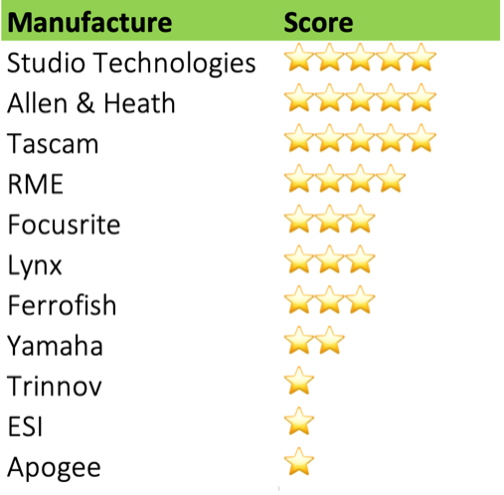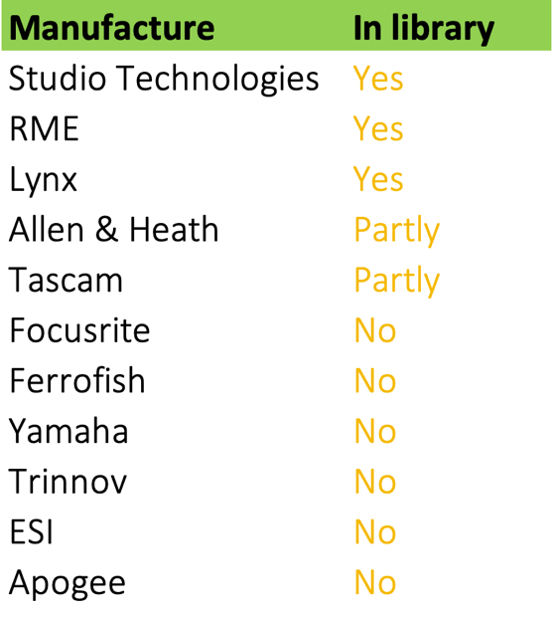Test
If you own Dante hardware equipment you have to update the firmware now and then to keep it in good shape. With non-Dante hardware this is most of the time a well-defined and hopefully easy job. But with Dante hardware there is a little snake into it that can endanger the future of the Dante technology. We investigated 11 manufacturers how they deal with the Dante firmware update. Let’s dive into it.
How should a Dante Firmware update work
Almost all interface hardware that deals with digital audio has the option for a firmware update. It even has become a part of the industry marketing strategy. Create some major updates of the firmware for their products during its life cycle. Giving the product multiple times media attention, shortening the time-to-market, and extending the lifetime of the product.
Dante enabled hardware is no exception to this strategy. But there is one specialty here. Besides maintaining the firmware of the manufacturer’s product there is also a second element that need firmware maintenance. That is the Audinate interface that is responsible for the Dante functionality. This hardware plugin-board inside the unit is not made by the hardware manufacturer but (made) by Audinate. Most of the manufactures make use of these plugin-boards from Audinate.
The plugin-boards have their own processor and software running. In this way Audinate makes sure that Dante equipment can talk to each other and evolve during time.
When you update the firmware using the manufacturer’s update procedure the Dante firmware is not updated. You need to do a separate action. The question is: “how are hardware manufactures implementing this action into their product support”?
I checked Focusrite, Yamaha, Ferrofish, Trinnov, RME, ESI, Tascam, Allen & Heath, Apogee, Lynx and Studio Technologies on their Dante firmware handling.
I will go through 2 routes. First route I start on the website from the manufacture. This is the most common path. Secondly, I start from Dante Controller. Let’s go.
A visit to the manufacturer’s website to check their Dante firmware update options
The first part of my Dante firmware update investigation was their websites. On all 11 manufacturer’s websites I checked 3 things. Is the Dante firmware available? Is the Dante plugin-in module firmware update described in the product manual? And is the proposed update procedure doable in practice.
From the 11 manufactures there are 4 companies that have the Dante firmware update well organized and therefore received a 4 or 5-star rating. The other 7 do not have it (fully)organized and therefore perform below customer’s expectations (3 star or less). So, this means that 64% of the manufactures in this test do not have the Dante firmware handling well organized for their customers. Below the results per manufacture.

You can find the details of the investigation in this linked PDF-file.
As a customer you expect a 4- or 5-star rating for the fundamental parts of the equipment that you buy. Firmware handling is one of them. It almost looks like a lack of responsibility at the manufacturer’s side regarding the installed third party Audinate module within their hardware equipment. This should be a concern for both the industry and Audinate.
Firmware update via Dante Controller
The second part of my Dante firmware update investigation is via Dante Controller. In the Dante Controller software there is a Dante firmware update module as well. If you open this, you will find three categories.
- Dante hardware that can receive a firmware update real-time through the application. This function works for all Audinate hardware.
- A firmware database. Here you find a list of manufacturers and the firmware for each product. If the product is listed in the database, you can download the firmware. But after that you still need an upgrade procedure for your hardware.
- The last option is the “ask the manufacture” category. As the name suggests, nothing is organized between Audinate and the manufacturer, so you must deal with it yourself. Most of the big brands are listed here.
I checked for the brands Focusrite, Yamaha, Ferrofish, Trinnov, RME, ESI, Tascam, Allen & Heath, Apogee, Lynx and Studio Technologies if they are listed in the firmware library of Audinate. Three companies are available with correct information in the Audinate library. Two companies are partly in the library. Six companies do not have their firmware added to the Audinate firmware library. Below the results per manufacturer.

Is the Dante firmware update the Achilles heel of the Dante eco-system?
The introduction of Dante technology is relatively fresh (~ 10 years de-facto standard) and as it usually goes with new technology that aims to be a new world standard its evolution comes with some rough edges. In Dutch we would say “the wild west phase”.
My investigation shows that the handling of the Dante firmware update is clearly not yet implemented thoughtfully by the industry with 64% of the large manufacturers not fulfilling the expectations.
The answer to this is around the corner. The Dante firmware library that Audinate develops within Dante Controller software should be the most logical way to go. But as this article shows there is still a long way to go. It looks like most manufacturers don’t feel responsible for this part of their product.
If the industry does not solve this Dante firmware handling then the end user will face serious compatibility issues in the future with their current hardware. Dante enabled hardware is not cheap and the investment should last for several years. If not, Dante technology will fail with its goal of becoming the (de-facto) world standard for audio over IP.
Become a member and leave a comment at our Facebook Group All4Dante
Click here: All4Dante
About All4Dante
All4Dante is an independent platform for Dante equipment and networks. We perform tests and reviews of equipment in our own Dante lab and share the results on our platform. We have a vision for Dante in the recording and pro-studio environment as well as in the music instrument segment. By experimenting and testing we want to find out what AoIP can do for us.



